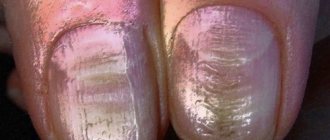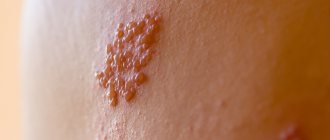Syphilitic chancre is an ulcerative or erosive formation that appears in the primary stage of syphilis infection and is its main symptom. There are 13 types of chancre due to syphilis: ordinary and atypical. Syphilis is treated with medications and a special regimen.
Varieties of chancre
Syphilitic hard chancres are dark red, evenly shaped ulcers with clear boundaries and slightly raised edges that appear after infection with syphilis. You can see what this formation looks like in the photo:
There are 10 main forms of chancre:
- unit;
- multiple;
- giant;
- dwarf;
- diphtheritic;
- cortical;
- slit-like;
- erosive;
- burn;
- herpetiform.
Important!
All varieties appear a month after infection and disappear after 20-50 days. Their occurrence is often accompanied by inflammation of the lymph nodes and blood vessels. Unlike trypanosomal chancroid, hard syphilitic chancre is usually not accompanied by severe symptoms. It does not itch, is not accompanied by a burning sensation, and only hurts when localized near the urethra or anus.
Single (regular, simple)
A single chancre, also known as a “common” or “simple” chancre, is the classic manifestation of syphilis and is found in most cases of infection. Their diameter is 2-3 cm, the edges are clear, slightly raised.
Simple chancre can be localized in different areas:
- Genital
: on the penis in men, on the labia majora and minora, as well as in the vagina in women, in some cases on the cervix. - Extragenital
: on the face, on the legs and pubic area, in the armpits, near the anus, on the chest in women, in the mouth - on the tongue, on the gums, in the throat, on the lips.
The genital location of syphilomas is more common: about 90% of all cases of the disease are accompanied by hard chancre in the genital area.
Multiple
Multiple ulcers form very rarely: in 8-12% of cases. There are 2 subtypes of profuse syphilomas: twin chancres, which appear during simultaneous infection, and sequential hard chancre, which occur during infection at different times.
Factors that provoke the formation of a large number of syphilomas include:
- skin injuries;
- ulcerative formations on the skin;
- skin infections: scabies, eczema;
- acne disease.
Unlike single syphilomas, multiple chancre can be localized bipolarly: in both the genital and extragenital areas simultaneously. The number of ulcers depends on the specifics of the patient’s body, and ranges from 2 to 10 pieces.
Giant
Large and very large syphilomas occur in 10-15% of cases of syphilis infection. In diameter they can reach 4-5 cm or more, matching the size of a child's palm.
Giant chancre occurs in areas rich in subcutaneous fat:
- on the pubis;
- on the stomach;
- on the hips;
- on the scrotum;
- on the forearms.
Apart from size, a giant syphilitic ulcer is no different from a regular one.
Dwarf
Dwarf syphilomas are called poppy seed sized syphilomas, with a diameter not exceeding 1-5 mm. Such ulcerative formations can only be seen with the help of a magnifying glass.
Dwarf chancres are often located:
- In the oral cavity: on the tongue and gums, on the roof of the mouth, in the throat.
- On the external genitalia: on the labia majora and minora, on the penis.
- In the area of the armpits and anus.
- Inside the vagina and on the cervix in women.
In medical practice, small primary syphilomas are rare. In women, dwarf ulcers form 3-4 times more often than in men.
Diphtheritic
Hard chancres with an unusual appearance are called diphtheritic: unlike simple ulcers that have a smooth and shiny surface, they are covered with a necrotic film of an ashy-grayish hue.
Syphilomas of this type are common and can be localized in any area.
Cortical
Chancre with crusting on the surface occurs in areas where the ulcer can easily dry out:
- on the face (nose, chin, lip skin);
- on the shaft of the penis;
- on the stomach, especially in the lower part.
Visually, the cortical type of syphiloma may resemble ecthyma or impetigo.
Slit-shaped
Slit-shaped chancre visually resembles a crack or book leaves.
They are located in small skin folds:
- in the corners of the mouth;
- in the folds between the fingers;
- in the pubic folds;
- in the anal area.
They are very rare: only 5-7% of cases of syphilis. Slit-like chancres are more common in men.
Erosive (Folman's balanitis)
Erosive chancre, also known as Folman's balanitis, is a primary syphiloma that does not have a clear compaction at the base and combines many sharply limited erosions, partially merging with each other.
It occurs exclusively in the genital area:
- on the head of the penis in men;
- on the labia of women.
In 87% of cases of Folman's erosive chancre, it appears in men.
Burn
Burn, or combustioform chancre is an erosion on a leaf-shaped base, which has a weak, unexpressed compaction at the base. This type of erosion is prone to strong peripheral growth.
As it grows, burn syphiloma loses its smooth contours and regular shape, and its bottom becomes granular, with a pronounced red tint.
Herpetiformis
Chancroid herpetiformis has a strong resemblance to genital herpes. This erosive formation resembles Folman's balanitis: it contains many grouped erosions with sharp edges located nearby in a small area.
Small erosions that make up chancre herpetiformis have a vague compaction at the base. This type of syphiloma differs from burn and erosive ones in its regular shape, as well as the absence of fusion between its component parts.
Vesicular syphilide
Vesicular syphilide occurs in severe syphilis. The main places of localization of syphilides are the skin of the extremities and torso. On the surface of the formed plaque, which is red in color, many grouped small vesicles (bubbles) with transparent contents appear. The vesicles quickly burst. In their place, small erosions appear, and when they dry, crusts form on the surface of the rash. When cured, a pigment spot with many small scars remains at the site of the lesion.
The rashes are resistant to therapy. With subsequent relapses they appear again. Vesicular syphilide should be distinguished from toxicerma, simple and acute herpes.
Atypical forms of syphilitic chancre
Atypical chancres are types of syphilomas that differ from the usual types in one or more characteristics.
These include:
- Chancroid felon:
an ulcer with jagged edges that appears on the fingers. Most often it occurs on the index finger and thumb, accompanied by shooting pain, swelling, blue discoloration and suppuration. This is an “occupational disease” of surgeons and gynecologists who violate safety regulations. - Indurative edema:
chancre in the genital area, causing severe swelling, bluish skin and swelling of the genitals. Occurs on the labia and foreskin. Not accompanied by pain or inflammation. - Amygdalitis:
unilateral, less often bilateral chancre, located on the tonsils. Enlarges and deforms the tonsil on which it is located, which can cause pain. The color of the tonsil tissue does not change, so the disease can be confused with a sore throat.
With the exception of these features, atypical forms of chancroid do not differ in any way from the usual varieties. The development of atypical syphilomas, the time of their appearance and disappearance are similar to the classical forms.
Provoking factors
With the use of modern treatment methods, the tertiary stage of syphilis develops extremely rarely. The factors that provoke primary syphilis most often are old age or infancy (secondary and tertiary are the most dangerous).
Lack of treatment, or incorrectly calculated doses of medications, if secondary syphilis was treated:
- Failure to maintain personal hygiene, living in unacceptable social and living conditions;
- Injuries, chronic diseases;
- Immune system dysfunction, accompanied by immunodeficiency;
- Physical, mental and mental stress accompanying secondary syphilis;
- Poor nutrition, lack of the required amount of proteins, vitamins and microelements in food.
If secondary syphilis was not identified and treated in a timely manner, then it becomes the most common cause of the disease transitioning to the tertiary stage, the symptoms of which are described below. Predisposing factors to this are also alcohol addiction, smoking and promiscuity. However, patients in whom syphilis has reached the tertiary stage of development may not be infectious. Treponema pallidums are located inside the granuloma and die when they disintegrate.
How chancroid develops
Primary syphiloma forms after the incubation period has passed: 3-4 weeks after contracting the infection. It occurs in places with skin lesions in which natural body fluid contaminated with bacteria has entered: sperm, secretion of the uterine cervix.
An ulcer does not appear immediately. Initially, a red spot appears on the infected area, which, under the influence of treponemas and cells of the immune system, thickens and turns into a nodule. The compaction is not accompanied by pain or discomfort, and therefore often goes unnoticed by the patient.
Over the next 7-10 days, the nodule develops: it increases in size, thickens and then ulcerates. Ulceration can be of two types: superficial, in the form of erosion, or deep, in the form of an ulcer. The ulcer or erosion takes on its final form: it acquires clear, pronounced boundaries, an even oval or round shape.
At the bottom of the manifested syphiloma, a liquid is released containing a large number of pale treponema and cells of the immune system. The bottom itself acquires a pronounced red tint with bluish notes.
This type of chancre persists for 1-2 months, after which the process of healing and tightening begins. This signals the transition of the disease to a secondary, more dangerous and severe stage.
3-4 days before the chancre disappears, multiple rashes appear on the patient’s body, often accompanied by burning and itching.
Rash due to secondary syphilis
Secondary syphilis is characterized by the appearance of a rash on the skin and mucous membranes - secondary syphilides. The rash with secondary fresh syphilis is abundant and varied (polymorphic): spotted, papular, vesicular and pustular. The rash can appear on any part of the skin and mucous membranes.
- The most abundant rash at the first rash, often symmetrical, the elements of the rash are small in size, always brightly colored. Often against its background one can detect residual signs of primary syphiloma (chancre), regional lymphadenitis and polyadenitis.
- Secondary recurrent syphilis is characterized by less profuse rashes. They are often grouped to form fancy patterns in the form of garlands, rings and arcs.
- The number of rashes in each subsequent relapse becomes less and less. At the end of the second stage of syphilis, monorelapses occur, when the clinical picture is limited to a single element.
Elements of the rash in secondary syphilis have some features: high prevalence at the beginning of the secondary period, sudden appearance, polymorphism, clear boundaries, peculiar coloring, lack of reaction of surrounding tissues, peripheral growth and subjective sensations, benign course (often the rash disappears spontaneously without scarring and atrophy), high contagiousness of the elements of the rash.
Rice. 2. Manifestations of secondary syphilis - syphilitic seizure.
Tertiary roseola
A rare type of tertiary syphilis, the photo of which is posted below. It is a pale pink spot with a diameter of 15 centimeters or more. Groups of spots are localized in the arms, legs and sacrum. Their appearance is associated with vascular disorders. The spots may merge, forming different patterns on the skin.
Patients have no subjective feelings about the appearance of spots (nothing bothers them). Roseola remains viable for 1 year, after which it disappears or recurs. A soft scar forms in their place.
Diagnosis and treatment
Diagnosis of tertiary syphilis is based on obtaining clinical and laboratory test results. To identify the stage of the disease, a RIF (immunofluorescent reaction) and a RIBT blood test are performed. In order to identify the extent of damage to individual internal organs, patients are referred for cardiac ultrasound, ECG examination, aortography, and bone x-ray.
Treatment of tertiary syphilis begins with taking erythromycin or tetracycline. Upon completion of a two-week course of antibiotics, the patient is prescribed penicillin therapy, combined with intravenous administration of Bismuth.
If there are contraindications to this drug, additional penicillin-containing medications are prescribed. The duration and treatment regimen depend on the form and degree of neglect of the disease. Simultaneously with treatment, blood counts are regularly measured, ECG and ultrasound data are studied,
The tertiary period of syphilis is extremely dangerous, characterized by multiple complications, but fortunately, it is rare; modern diagnostic tools make it possible to identify the first signs of the disease at an early stage.
Prevention
It is enough to see at least once what syphilis looks like to forever decide to give up promiscuous sexual intercourse. This is the most effective way to prevent this disease.
If a person has to live with a sick person, strict hygiene rules must be observed. Despite the fact that the risk of household transmission of infection is minimal, it still exists. Also, a person living with an infected person must periodically visit a doctor and undergo diagnostics to make sure that infection has not occurred.
If you have sexual contact with an infected person, it is recommended to immediately urinate, wash your genitals with laundry soap, and wipe your private parts with a disinfectant solution. This treatment is effective only in the first 48 hours after possible infection, since during this period of time the pathogen is still on the skin and mucous membrane. After more than 3 hours, such treatment is useless.
Syphilis is a dangerous disease that in the vast majority of cases is transmitted sexually. The disease is insidious in that even in the absence of symptoms, it can affect any organ of the human body and provoke various ailments. It is important to understand that cure for syphilis does not guarantee protection against re-infection. Immunity to Treponema pallidum is not developed. Therefore, you should always adhere to preventive measures, and at the first suspicion of a disease, immediately consult a doctor. With timely treatment, syphilis can be successfully treated. But untreated syphilis will destroy the body for years and can be fatal.










